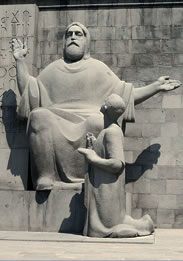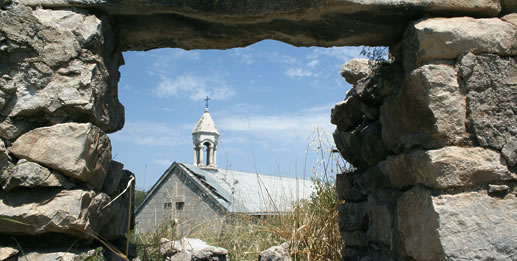Principality of Varanda
The history of the Amaras Monastery in medieval period is tied to the rise of the Principality of Varanda — one of the five autonomous feudal states in historical Nagorno Karabakh (Artsakh). After the disintegration of the Bagratid Kingdom of Armenia in 1064 and the downfall of the Armenian Kingdom of Cilicia in 1375, the five principalities continued the tradition of Armenian statehood through the 19th century.
According to the 7th century atlas Ashkharatsuits, which defined Armenia’s political geography and gave impressive details about its 15 provinces, Varanda largely overlaps with the ancient district of Mius Haband (Armenian: Մյուս Հաբանդ) that lies in the central part of Artsakh — Armenia’s 10th historical province. [1]
The Armenian historian and novelist Raffi (1835-1888), who studied Nagorno Karabakh in his seminal work Melikdoms of Khamsa, mentions that the lands of Varanda begin from the banks of the River Meghraget (Baluchai) in the north and end with the Dizapayt Mountains and the River Ishkhanaget in the south. Amaras is thus located in the eastern part of Varanda, where the Artsakh Mountains gradually give way to the vast and fertile lowlands known for their mulberry orchards, wheat fields and legendary vineyards producing the medicinal Hindeghna grapes.
The pre-history of Varanda starts with the invasion of the South Caucasus by the Central Asian tyrant Tamerlane in the 14th and 15th centuries. The invasion delivered a deadly blow to many areas of Armenia, including Gegharkunik — a highland province that wraps around the Lake Sevan. At that time, the province was dominated by several feudal families, most of whom claimed lineage from ancient Armenia’s Gegharkuni (Geghamid) dynasty. The 5th century author Movses Khorenatsi describes Geghamids in his History of Armenia as descendents of semi-mythical hero Gegham, a grandchild of Patriarch Hayk — the eponymous progenitor of the Armenian people from the Bronze Age. [2]
The princely family of Melik-Shahnazarians was one of the Geghamid clans. Their strongholds were the towns of Sotk (Armennian: Սոտք) and Mets Masrik (Armenian: Մեծ Մասրիկ). These settlements are currently in the eastern part of the Gegharkunik province of the Republic of Armenia. A different theory suggests that the Melik-Shahnazarians were a branch of the Dopian kings of Upper Khachen — a feudal dynasty that ruled the northwestern part of Nagorno Karabakh in the High Middle Ages. [3] Indeed, Gegharkunik had had permanent geographical, political and dynastic ties to Artsakh. The Principality of Khachen extended well into the Shahnazarians’ domain on the eastern shores of the Lake Sevan during its utmost expansion under Hasan Jalal Vahtangian (ruled from 1214-1261).
Tamerlane’s invasion decimated Gegharkunik’s peasantry, and the province suffered a demographic collapse as a result. That event, coupled with the permanent threat of marauding raids from Dagestan, prompted the Melik-Shahnazarians to think about moving to a place in the neighboring land of Artsakh — a more fertile land, which had largely survived Tamerlane’s invasion due to its superior fortifications, warlike inhabitants and impassable mountains covered with thick forests.
Melik-Shahnazarians in Varanda
In the mid-15th century, Muzaffar al-Din Jahan Shah ibn Yusuf, ruler of Iran of the time, re-confirmed hereditary titles of Armenian princes (meliks) in present-day Nagorno Karabakh and adjacent territories. That allowed the Melik-Shahnazarians to expand their possessions in the Varanda Valley in Artsakh by adding to their new realm the southern valleys of the Principality of Khachen and the northern part of the Principality of Dizak. The rights of Prince Mirzakhan Melik-Shahnazarian and his princely status of meliks were confirmed again by the Shah Abbas I of Iran in 1596. [4]
A branch of the Melik-Shahnazarian family also acquired lands in Artsakh’s northern district of Gardman, forming a smaller Principality of Voskanapat, located in the mountains south of the city of Gandzak (modern Ganja, in the modern-day Azerbaijani Republic).
The political center of Varanda, with the seat of Varanda’s melik, was in the historical town of Avetaranots (Armenian: Ավետարանոց). This settlement is situated in the Varanda Valley and is surrounded by dense forests that grow on the slopes of Mount Kirs. The name Avetaranots comes from the Armenian word Avetaran (Ավետարան), which means “Gospel.” According to a legend recorded in the mid-19th century by Archimandrite Sargis Jalalyants, Vachagan III the Pious (reigned from 487–510), ruler of Armenia’s Kingdom of Aghvank, spent his last years in Avetaranots where he devoted himself to the studies of the Holy Scripture. [5] Locals call the town by its abridged name — Utranots.
Avetaranots is home to several notable churches, such as the temple of the Holy Mother of God (1651) and the female hermitage Kusanats Anapat (1616). In different parts of the town one can see old aparanks (mansions) and other structures belonging to the Melik-Shahnazarian dynasts. [6] Three of such mansions survived to this day. They belonged to Baghi Melik-Shahnazarian, Husein I Melik-Shahnazarian, and Sahnazar II Melik-Shahnazarian.
Avetaranots was part of a unique-to-Nagorno Karabakh system of fortifications, recruitment centers, gunsmith workshops, and fire beacons known as syghnakh. Syghnakh-related infrastructure was formed in each of the five Armenian principalities in Nagorno Karabakh — Varanda, Dizak, Khachen, Jraberd and Giulistan. This infrastructure was divided into two main war camps: the Larger Syghnakh (Armenian: Մեծ Սղնախ), centered around Giulistan, Jraberd and Hohanaberd fortresses in the north, and the southern Lesser Syghnakh (Armenian: Փոքր Սղնախ), which relied on the citadels of Shushi, Togh and Mairaberd.
The citadel of Shushi was the centerpiece of Varanda’s defense network. It also included two special settlements whose population provided military services to the melik. The village of Shosh was responsible for the upkeep of the Shushi fortress. Somewhat similarly to Cossack settlements in Russia or Ukraine, the second village, pointedly called Syghnakh, supplied recruits who formed the backbone of melik’s fighting force.
A good illustration of power of syghnakhs in action was the Armenian heroic self-defense during the Ottoman-Persian wars in the 1720s-1730s. At that time, the five principalities of Karabakh joined forces to form a united front against Ottoman invaders. The towns of Avetaranots and Shosh gave several notable military leaders who distinguished themselves in that struggle, including Avan the Centurion — a native of Shosh who became supreme commander of all of Nagorno Karabakh’s syghnakhs in the 1720s. For its part, Avetaranots was the birthplace of the brave maiden Gaiané, a key figure in the epic destruction of a Turkish expeditionary corps that entered Varanda in 1733.
Gaiané was the daughter of Varanda’s ruler Husein I Melik-Shahnazarian. She pretended to accept the advances of Suleiman-Bek, an Ottoman pasha (general), and agreed to marry him in order to kill him at a right moment before the wedding. When Gaiané mother, Princess Anna — the daughter of the mighty Prince Yegan of Dizak — passed a signal to her fellow villagers to slaughter Turkish soldiers stationed in their homes, Gaiané found Suleiman-Bek and plunged a dagger into his heart. After the battle, Gaiané entered monastic life at the Kusanats Anapat hermitage in her native town, and became a recognized scribe. Some of the religious texts transcribed by Gaiané can be found at the Matenadaran — Armenia’s institute and museum of ancient manuscripts. Leo (Arakel Babakhanian, 1860-1932), Armenian historian and native of Nagorno Karabakh, made Gaiané’s story the centerpiece of his novel Melik’s Daughter.
The tombstone of Gaiané’s father Husein I Melik-Shahnazarian in Avetaranots contains the following famous epitaph, made in 1736. It could be seen to this day, and was first mentioned in Raffi’s seminal work on late medieval and early modern Nagorno-Karabakh entitled Melikdoms of Khamsa (1883): [7]
He was the Lord of Varanda, With thirty five villages, His table was groaning with bread, He gave alms to everyone, He was handsome, a pride of the Armenian people, He battled with the cursed Ottomans, He never paid tribute to any king, And was a strong defender of his land.Since the Lord of Varanda did not outright own the villagers in his land as serfs, he was compelled to provide incentives for Syghnakh’s men to remain in his service. He exempted Syghnakhians from taxation and gave the village’s key families farmland in Varanda’s eastern territory, near the Amaras Monastery. In vineyards near the monastery, the ancient Marutants clan of Syghnakh cultivated the legendary Hindeghna grapes, which were thought to posses unusual medicinal qualities due to the divine influence of the monastery’s patron saints — St. Grigoris and St. Pandalion. Curiously, when Varanda became part of the Russian Empire in 1805, the Russian administration of the region opted to preserve fiscal privileges and land possessions of Syghnakh residents.
The town of Avetaranots was linked to the historical Marutants family (Armenian: Մառութանց ազգ), who claimed lineage from Patriarch Marut, an azgapet (chieftain) from the Varanda Valley. Marut’s name features among the 14 signatories of the Constitution of Aghven. The constitution, consisting of 21 canons, was adopted in the 5th century and found in full text in Book One of the 7th century Old Armenian manuscript History of the Province of Aghvank. [8] The Constitution of Aghven is valued as a document that laid the foundations of Armenia’s legal thought. According to an oral tradition, Marut was a confidant of Vachagan II the Pious, King of Aghvank, and a key reason behind King Vachagan’s decision to spend his last years in Varanda’s capital of Avetaranots.
The last representative of the Melik-Shahnazarian family with the full princely title of melik was Hudadad Melik-Shahnazarian (1792-1833). After him, the Melik-Shahnazarians lost most of their feudal privileges and assets, and went into service for the Russian Empire as hereditary — but landless — noblemen.
The Melik-Shahnazarians took good care of the Amaras Monastery. Shahnazar II Melik-Shahnazarian, the most controversial representative of the dynasty, restored the Amaras Monastery in the late 1780s.[9] He died in 1792. By restoring the monastery, the prince was hoping to achieve forgiveness for a heavy sin — his union with the Muslim nomadic chieftain Panakh Ali Jevanshir, who settled in the fortress of Shushi and with whose help he fought against other four Armenian princely families in Nagorno Karabakh in 1750s-1770s (i.e. Melik-Beglarians of Giulistan, Hasan-Jalalians of Khachen, Melik-Israelians of Jraberd, and Melik-Yeganians of Dizak). Melik Shahnazar II repaired a tall wall with four turrets around the monastery and built a refectory and a number of other ancillary structures.
The last restoration of the monastery in 1858 was likewise initiated by Melik-Shahnazarian descendants who lived in the city of Shushi — the administrative and cultural center of Artsakh that was built within the walls and received its name from Varanda’s main fortress.
[1] Anania Shirakatsi. Ashkharhatsoyts, translated from Old Armenian by Robert H. Hewsen. Caravan Books, 1994. Hewsen, Robert H. Armenia: a Historical Atlas. Chicago, IL: University of Chicago Press, 2001
[2] Moses Khorenatsi. History of the Armenians, translated from Old Armenian by Robert W. Thomson. Harvard University Press, 1978
[3] Артак Магалян. Шахские фирманы и надгробные надписи Варанды. Журнал Анив. 04.11.2007 №6 (9). Historical Upper Khachen lies in the Mardakert and Shahumyan counties of the present-day Nagorno Karabakh Republic
[4] Chorbajian, Levon; Donabedian Patrick; Mutafian, Claude. The Caucasian Knot: The History and Geo-Politics of Nagorno-Karabagh. NJ: Zed Books, 1994, chapter: The Armenian Meliks under Persian Occupation, p. 70
[5] Архимандрит Саргис Джалалянц. Путешествие по Великой Армении. Тифлис, 1842, 1858
[6] See: Artak Ghulyan. Melik Mansions in Artsakh and Syunik. Research on Armenian Architecture series. Volume 4, Gitutiun publishing house, Yerevan, 2001 (in Armenian)
[7] Raffi. Melikdoms of Khamsa. Yerevan, Sovetakan Grogh, 1987, p. 52
[8] Movses Kalankatuatsi. History of the Land of Aluank, translated from Old Armenian by Sh. V. Smbatian. Yerevan: Matenadaran (Institute of Ancient Manuscripts), 1984, Book One
[9] Chakagh magazine. Moscow, 1859, volume 10, page 339. See: Artak Maghalyan. The Melikdoms of Artsakh (Karabakh) and Melik Houses in the 17-19th Centuries. Yerevan, Gitutiun, 2007, p. 79




